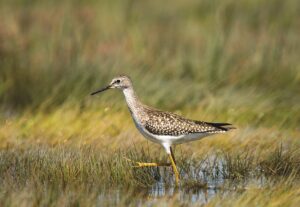On Wellfleet’s saltwater marshes, at low tide, the grasses stand high over a vast, muddy plain. Six hours later, those same grasses are half-submerged, or standing on islands with deep channels between them. This constant transformation is hard to fathom in any other part of the natural world — imagine a meadow that turned into a forest and back every 12 hours, or a mountain range that grew and shrank by 10 feet. It seems like a miracle that any animal could survive this endless change. But shorebirds thrive in this ever-shifting world.
Shorebirds are notoriously difficult to tell apart: pretty much every one of them is long-legged and drab, best identified by their body shapes and subtle differences in their feather patterns. They are also skittish and tend to stick to mudflats and the edges of sandy beaches. Looking at these birds can feel like watching distant scurrying brown blobs.

But they are remarkable, too. Shorebirds hunt by jamming their sensitive bills into the muck and feeling for prey, hunting purely by touch. They form mega-flocks numbering well into the thousands. And they undertake some of the longest migrations on the planet: Most shorebirds breed in the tundra or boreal forests of Alaska and Canada and winter in tropical wetlands as far south as the southern tip of Argentina. This migration spans tens of thousands of miles, and Cape Cod is an important refueling stop on the journey.
To better understand how these birds behave as the tide ebbs and flows, I went to one of the places where the tide changes things most noticeably on the Outer Cape: the Lieutenant Island bridge in Wellfleet.
Shortly after high tide, I saw a double-crested cormorant, with its snake-like black neck, dive below the water’s surface to chase fish. Common and Forster’s terns crashed into the water from high above the marsh, emerging with fish in their bills. The only shorebird in sight was a willet, a gangly, foot-long grayish bird, napping on the channel’s steep bank.
High tide covers up nutrient-rich mud that is loaded with worms, crustaceans, and other invertebrates. As the water level goes down, the prey are exposed. And as I waited, larger shorebirds started taking notice of the dropping water level.
First, a short-billed dowitcher flew in to join the willet. Despite their name, these birds’ bills are nearly as long as the rest of their bodies. They use them to probe the mud in a distinctive sewing machine style, shoving their bills down until their faces nearly hit the mud and drawing them back out. Then a whimbrel, a massive brown shorebird with a striped face and curved bill, flew in to feed. Bigger shorebirds like these are among the first to take advantage of the exposed tidal flats — their long legs and bills allow them to feed more easily in this environment.
An hour into my vigil, a significant stretch of mud had been exposed south of the bridge. Now a group of shorebirds took up residence there. The flock included willets and dowitchers, but it also included greater and lesser yellowlegs, tall, dainty shorebirds with needle-like bills, checkered wings, and those namesake bright yellow legs. Larger black-bellied plovers arrived, too, and mingled among the much smaller semipalmated plovers. Like their better-known piping relatives, semipalmated and black-bellied plovers are chunky and have stubby bills that allow them to feed on prey near the mud’s surface.
Soon, these birds fell into their established roles. The long-billed shorebirds — dowitchers, yellowlegs, willets, whimbrels — waded out into the shallow water where they could feed on not-yet-exposed mud. Meanwhile, the plovers took up residence on the exposed flats where they were soon joined by the tiny semipalmated and least sandpipers. Even among other shorebirds, these sandpipers are exceptionally minuscule — an adult least sandpiper rarely weighs more than a pair of cherry tomatoes. The birds stay out of each other’s way; some birds go deep, while others stay shallow.
By my third hour on the bridge, the channel was a shadow of its former self. The cormorants were gone, having flown to deeper waters in the bay. The terns, too, had stopped fishing and rested with the shorebirds on the mudflats. Marsh grass that was once completely underwater stood at the crest of small islands, and the mudflats had gotten so expansive that shorebirds occupied spots far up and down the channel. More kept arriving to feast on the bounty, and the air was full of their whistle-y calls.
Any concentration of prey, though, is bound to attract predators.
I heard the alarm call of a greater yellowlegs: a sharp, high-pitched “tew-tew-tew.” The other shorebirds joined in the cry and launched themselves into the sky. Then the cause of their alarm came into view; it was a Cooper’s hawk, a sleek raptor perfectly built for hunting small birds.
The shorebirds rocketed north over the bridge in big, swirling flocks. The Cooper’s chased them with pounding wingbeats, but its prey had spotted it too early. As the shorebirds disappeared into the distance, the hawk swooped up and landed on the bridge, catching its breath. It scanned the marsh in search of prey, and it met my gaze. Our eyes locked and it bolted, flapping away as swiftly as the shorebirds it had hoped to catch.
I spent another hour on the bridge, but the shorebirds did not return, save for one brave greater yellowlegs. By this point, the bay offered miles and miles of mudflats for these birds to retreat to, which they are happy to do if a predator is causing trouble. These shorebirds are familiar with change. Relocating a few miles is nothing when you are used to traversing hemispheres. I ended my watch there.



